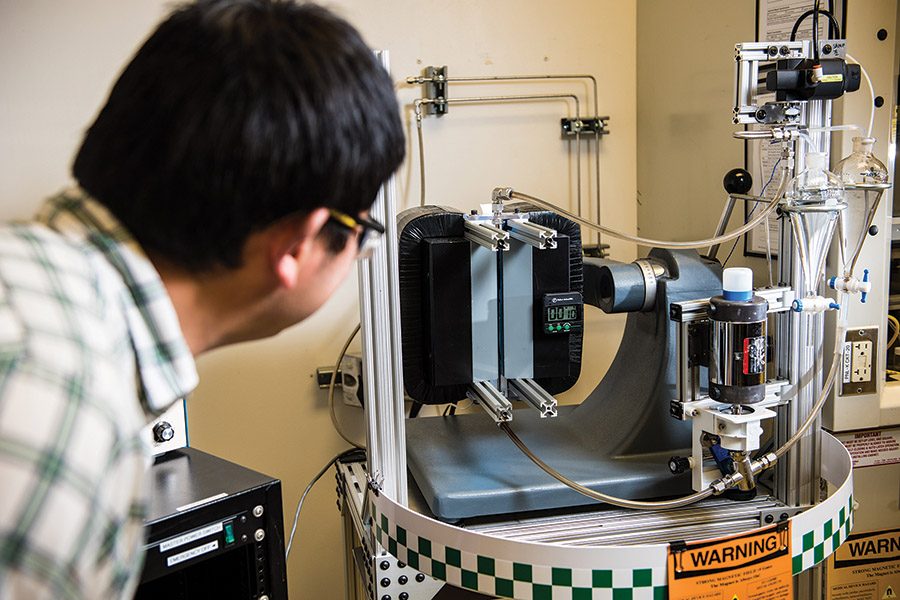
Home » PNNL patents method of extracting lithium from water
PNNL patents method of extracting lithium from water

July 13, 2022
The alchemists of yore sought to convert low-value lead into high-value gold.
A solution to that puzzle remains elusive, but researchers at Pacific Northwest National Laboratory have discovered something more applicable to present-day challenges.
The lab has patented a game-changing new method of extracting lithium from water.
There is a lot more suspended in H2O than just loosely bonded hydrogen and oxygen.
Take for example mining effluent produced through oil and natural gas drilling. In the resulting wastewater brine generated during hydraulic fracturing (fracking) and other processes, sediments from deep within the earth are brought to the surface along with the water used to facilitate the drilling process.
Among that material are traces of highly valuable rare earth metals, such as lithium, which are sought after by makers of semiconductors, wind turbines, electric vehicle (EV) batteries and the smaller rechargeable lithium-ion batteries in phones and other everyday electronics.
Though these elements were known to be present in such brines produced in drilling, geothermal and desalination plants, prior to PNNL’s breakthrough, the persistent question was how to isolate them in a way that was both practical and economically feasible.
The secret sauce
PNNL’s newly discovered method is based on a simple concept commonly observed in a classic grade school science experiment: using a magnet to attract iron filings, according to PNNL’s media relations advisor and science communicator, Karyn Hede.
Instead, in this case, a specialized magnet is designed to attract lithium.
Jian Liu, senior chemical engineer and one of the lead researchers on the project, explained that though it was known lithium could be extracted using a magnet, the question was how to isolate it from other magnetically attractive elements also present in brine.
Magnets are metals that indiscriminately attract other magnetic metals, lending to the difficulty of extracting just lithium.
The research team at PNNL – Pete McGrail, laboratory fellow and expert on rare earth metal recovery technology, Praveen Thallapally, principal investigator, and researchers Jian Liu, Satish Nune and Yongsoon Shin – realized they needed to develop a kind of filter that would select for lithium.
The team’s many joint years of experience working with adsorbents – materials that adhere atoms, ions or molecules in a solution to their surface rather than absorb them, which would make them harder to isolate – provided the answer to the puzzle.
Liu explained that his team “grows” a fine-tuned lithium-selective adsorbent – also called a ligand – on top of a black magnetite (iron oxide) magnet. This makes it so only lithium can bind to the adsorbent coating the magnet.
“The adsorbent is probably more valuable than the rare earth metals,” Liu said.
This led the team to another hurdle: “You have to be able to reuse (the adsorbent) or you are sacrificing one valuable material for another,” he said.
Fortunately, the magnetic nanoparticles used to isolate and extract lithium can be recharged and reused.
As McGrail explained in a PNNL news release, “Our nanotechnology process allows us to miniaturize everything and removes the need for massive ion exchange separators required in other processes.”
The brine water is instead passed through an extraction system, which houses the extracting nanoparticles.
“It’s quite simple. Within a few minutes, virtually all the lithium has been pulled from the solution by molecular collisions with our sorbent and can then be removed with a magnet where it’s easily collected and purified,” McGrail said.
The water is then returned to its source, otherwise unchanged.
Conventional methods using evaporation ponds can take months or even years to isolate lithium and have a lot more negative environmental impacts.
“I think this will be a technique that can be applied to a variety of different metals as long as you have a selective adsorbent,” Liu said. Other rare earth metals in high demand that might be targeted next are cesium, nickel and cobalt.
Industrial, environmental implications
The breakthrough stands to provide a much-needed relief to a strained industry.
Due to the exponentially increasing demand for rare earth metals in existing and emergent technology, costly and energy intensive methods of extraction are being pushed to the limits to meet that demand.
Green technologies such as EVs, for example, have been whittling down the cost of batteries since their inception, working to reach parity in overall cost compared to their traditional gas and diesel counterparts.
However, in recent years, that downward price trend has begun to plateau, hung up on the cost of production of the key ingredients: rare earth metals.
Currently, next to no lithium is produced in the United States.
The majority is produced in South America, primarily Argentina and Chile, as well as operations in Australia and China.
According to the Department of Energy, imports account for 100% of U.S. supply for 14 of 35 critical materials and more than half for 17 others.
Hede noted that many of those international sources are in high-conflict regions.
By 2028, the global market for lithium is expected to reach $8.2 billion.
“The cost of lithium has increased four times in just the past year alone,” Liu said.
With this breakthrough, the potential for the U.S. market is big.
Scientists at PNNL have estimated that if 25% of the lithium was collected from wastewater generated through oil and natural gas extraction, that alone would equal current annual worldwide production.
The additional revenue stream for these metal-rich brine producers could in turn decrease the cost of energy production.
“Why this is important,” Liu said, “is we are trying to propose a technology that can boost the production of lithium … so that the lithium battery price can maintain or even go down, in addition to nickel, cobalt and other metals … We can help to modernize the electric car industry and reduce greenhouse gas emissions. We have a lot of hope that this will solve a lot of big challenges for our community.”
Bringing it to scale
Due to Covid-19 and some technical issues along the way, Hede said the concept is still in the lab phase testing different adsorbent ligands.
There is one planned pilot project in the pipeline, co-funded by DOE’s Office of Fossil Energy.
Another will be in partnership with a renewable energy investment company, Moselle Technologies, which has licensed the technology and plans to pilot it at several of its locations.
Collaboration with Moselle and mineral recovery company Geo40 are also actively exploring paths for cesium and antimony extraction from brines at a geothermal plant in New Zealand.
Other commercial partners – Enerplus Corp., Prairie Lithium Corp., Enertopia Corp. and Dajin Lithium Corp. – with lithium resources in Nevada and Canada are on-board to investigate the extraction technology’s potential application at their sites.
Established in 1965, PNNL is operated by Battelle for the DOE’s Office of Science with the stated goal of advancing scientific knowledge and addressing challenges in sustainable energy and national security.
Local News Science & Technology
KEYWORDS july 2022





